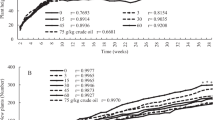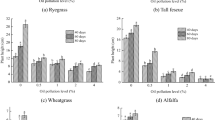Abstract
Responses to contamination of several soil types with crude oil were comparatively analyzed in organisms of different trophic groups. Samples of soddy podzolic, light gray, soddy calcareous, dark gray, and floodplain soils were supplemented with oil in concentration ranges of 1–5 and 100–300 g/kg and tested in the laboratory for the effect on heterotrophic soil bacteria and higher plants (Lepidium sativum, Triticum aestivum, Picea obovata, and Pinus sylvestris). In addition, water extracts from oil-contaminated soils were tested for the effect on Chlorella vulgaris and Daphnia magna. It was found that agricultural plants Lepidium sativum and Triticum aestivum were more tolerant of low-dose oil contamination (1–5 g/kg soil), compared to seedlings of the taiga tree species Picea obovata. The abundance of heterotrophic bacteria increased in soils treated with low oil concentrations (up to 5 g/kg) and decreased when oil concentration reached 100–300 g/kg soil. The entire range of tested oil concentrations caused reduction in the morphological diversity of heterotrophic soil bacteria. Experiments with water extracts from oil-contaminated soils showed that toxicity test with Daphnia magna was insufficiently sensitive and that the response of Chlorella vulgaris microalgae to soil contamination with oil was ambiguous. The floodplain soil proved to be most tolerant to oil contamination, while soddy calcareous and light gray soils were most vulnerable.
Similar content being viewed by others
REFERENCES
Akhmetzyanova, L.G., Selivanovskaya, S.Yu., and Latypova, V.Z., Laboratory modeling of petroleum-polluted soil remediation to determine allowable residual contents of petroleum products, Uch. Zap. Kazan. Gos. Univ., Ser. Estestv. Nauki, 2010, vol. 152, no. 4, pp. 68–77.
Lifshits, S.Kh. and Chalaya, O.N., Development of criteria for determining the allowable residual contents of petroleum pollutants in soils, Mezhd. Zh. Prikl. Fundament. Issled., 2013, no. 8-2, pp. 228–230.
Kolesnikov, S.I., Zharkova, M.G., Kazeev, K.Sh., et al., Ecotoxicity assessment of heavy metals and crude oil based on biological characteristics of chernozem, Russ. J. Ecol., 2014, vol. 45, no. 3, pp. 157–166.
Tang, J.C., Wang, M., Wang, F., et al., Eco-toxicity of petroleum hydrocarbon contaminated soil, J. Environ. Sci., 2011, vol. 23, no. 5, pp. 845–851.
Martinez-Jeronimo, F., Villasenor, R., Rios, G.F., and Espinosa-Chavez, F., Toxicity of the crude oil water-soluble fraction and kaolin-adsorbed crude oil on Daphnia magna (Crustacea: Anomopoda), Arch. Environm. Contam. Toxicol., 2005, vol. 49, no. 3, pp. 343–352.
Motuzova, G.V., Zagryaznenie pochv i sopredel’nykh sred (Contamination of Soils and Adjacent Media), Moscow: Mosk. Gos Univ., 2000.
Terekhova, V.A., Pukalchik, M.A., and Yakovlev, A.S., The triad approach to ecological assessment of urban soils, Euras. Soil Sci., 2014, no. 9, pp. 952–959. 1145-1152. https://doi.org/10.1134/S1064229314090129
Natsional’nyi atlas pochv Rossiiskoi Federatsii (National Soil Atlas of the RussianFederation), Moscow: AST, 2001.
PND F 16.1.41-04. Kolichestvennyi khimicheskii analiz pochv. Metodika vypolneniya izmerenii massovoi kontsentratsii nefteproduktov v probakh pochv gravimetricheskim metodom (PND F 16.1.41-04. Qualitative Chemical Analysis of Soil. Methods for Measuring the Mass Concentration of Oil Products in Soil Samples by the Gravimetric Method), Moscow: Minprirody RF, 2004.
Drugov, Yu.S., Ekologicheskie analizy pri razlivakh nefti i nefteproduktov: Prakticheskoe rukovodstvo (Ecological Analyses after Crude Oil and Petroleum Product Spills: Practical Guidelines), 2nd ed., Drugov, Yu.S. and Rodin, A.A., Eds., Moscow: BINOM, 2017.
GOST R ISO 22030-2009. Kachestvo pochvy. Biologicheskie metody. Khronicheskaya fitotoksichnost' v otnoshenii vysshikh rastenii (GOST R ISO 22030-2009. Soil Quality. Biological Methods. Chronic Phytotoxicity for Higher Plants), Moscow: Standartinform, 2019.
Gerhardt, F., Manual of Methods for General Bacteriology, Am. Soc. Microbiol., 1981 Translated under the title Metody obshchei bakteriologii, Moscow: Mir, 1983.
Ausbel, F.M., Brent, R., Kingston, R.E., et al., Short Protocols in Molecular Biology, 3rd ed., New York: Wiley, 1995.
PND F T 14.1:2:3:4.10-04, T 16.1:2:2.3:3.7-04. Metodika izmerenii opticheskoi plotnosti kul’tury vodorosli khlorella (Chlorella vulgaris Beijer) dlya opredeleniya toksichnosti pit’evykh, presnykh prirodnykh i stochnykh vod, vodnykh vytyazhek iz gruntov, pochv, osadkov stochnykh vod, otkhodov proizvodstva i potrebleniya (PND F T 14.1:2:3:4.10-04, T 16.1:2:2.3:3.7-04PND F T 14.1:2:3:4.10-04: Measurement Method of the Optical Density of the Culture of Chlorella Alga (Chlorella vulgaris Beijer) to Determine the Toxicity of Drinking, Fresh Natural and Wastewater, Water Extracts from Soils, Soil, Sewage Sludge, and Production and Consumer Waste), Moscow: Gosprirodnadzor, 2014.
PND F T 14.1:2:3:4.12-06, T 16.1:2:2.3:3.9-06. Metodika izmerenii kolichestva Daphnia magna Straus dlya opredeleniya toksichnosti pit’evykh, presnykh prirodnykh i stochnykh vod, vodnykh vytyazhek iz gruntov, pochv, osadkov stochnykh vod, otkhodov proizvodstva i potrebleniya me-todom pryamogo scheta (PND F T 14.1:2:3:4.12-06, T 16.1:2:2.3:3.9-06. The Method of Measuring the Amount of Daphnia magna Straus to Determine the Toxicity of Drinking, Fresh Natural and Wastewater, Water Extracts from Soils, Soil, Sewage Sludge, and Production and Consumption Waste by Direct Calculation), Moscow: Gosprirodnadzor, 2014.
Donets, E.V. and Grigor’ev, A.I., Impact of oil pollution on conifer seed germination, Lesovedenie, 2008, vol. 5, pp. 18–21.
Yakovlev, A.S. and Evdokimova, M.V., Ecological standardization of soil and soil quality control, Euras. Soil Sci., 2011, vol. 44, no. 5, pp. 534–547.
Baek, K.H., Kim, H.S., Oh, H.M., et al., Effect of crude oil, oil components, and bioremediation on plant growth, J. Environ. Sci. Health, 2004, vol. 39, no. 9, pp. 2465−2472.
Masakorala, K., Yao, J., Chandankere, R., et al., Effects of petroleum hydrocarbon contaminated soil on germination, metabolism and early growth of green gram, Vigna radiata L., Bull. Environ. Contam. Toxicol., 2013, vol. 91, pp. 224–230.
Abed, R.M.M. and Al-Kindi, S., Effect of disturbance by oil pollution on the diversity and activity of bacterial communities in biological soil crusts from the Sultanate of Oman, Appl. Soil Ecol., 2017, vol. 110, pp. 88–96. https://doi.org/10.1016/j.apsoil.2016.10.009
Bergsveinson, J., Perry, B.J., Simpson, G.L., et al., Spatial analysis of a hydrocarbon waste-remediating landfarm demonstrates influence of management practices on bacterial and fungal community structure, Microb. Biotechnol., 2019, vol. 12, no. 6, pp. 1199–1209. https://doi.org/10.1111/1751-7915.13397
Kuyukina, M.S., Ivshina, I.B., Kamenskikh, T.N., et al., Survival of cryogel-immobilized Rhodococcus cells in crude oil-contaminated soil and their impact on biodegradation efficiency, Int. Biodeterior. Biodegrad., 2013, vol. 84, p. 118–125. https://doi.org/10.1016/j.ibiod.2012.05.035
Zhang, C., Zhang, S., Zhu, L., et al., The acute toxic effects of 1-alkyl-3-methylimidazolium nitrate ionic liquids on Chlorella vulgaris and Daphnia magna, Environ. Pollut., 2017, vol. 229, pp. 887–895. https://doi.org/10.1016/j.envpol.2017.07.055
Lewis, M. and Pryor, R., Toxicities of oils, dispersants, and dispersed oils to algae and aquatic plants: Review and database value to resource sustainability, Environ. Pollut., 2013, vol. 180, pp. 345–367. https://doi.org/10.1016/j.envpol.2013.05.001
Kalhor, A.X., Movafeghi, A., Mohammadi-Nassab, A.D., et al., Potential of the green alga Chlorella vulgaris for biodegradation of crude oil hydrocarbons, Marine Pollut. Bull., 2017, vol. 123, pp. 286–290. https://doi.org/10.1016/j.marpolbul.2017.08.045
Romero, D.V., Cordero, A.P., and Garizado, Y.O., Biodegradation activity of crude oil by Chlorella sp. under mixotrophic conditions, Indian J. Sci. Technol., 2018, vol. 11, no. 29, pp. 1–8. https://doi.org/10.17485/ijst/2018/v11i29/127832
Lennuk, L., Kotta, J., Taits, K., and Teeveer, K., The short-term effects of crude oil on the survival of different size-classes of cladoceran Daphnia magna (Straus, 1820), Oceanologia, 2015, vol. 57, p. 71–77. https://doi.org/10.1016/j.oceano.2014.10.003
Bownik, A., Physiological endpoints in daphnid acute toxicity tests, Sci. Tot. Environ., 2019, vol. 700, Art. 134400. https://doi.org/10.1016/j.scitotenv.2019.134400
Funding
This study was performed within the Program of Actions of the Global Science and Education Center “Rational Subsurface Resource Management” for the years 2019−2024 (RF Government Order no. 537 of April 30, 2019) and supported by the Russian Foundation for Basic Research, project no. 18-14-00140.
Author information
Authors and Affiliations
Corresponding author
Additional information
Translated by N. Gorgolyuk
Rights and permissions
About this article
Cite this article
Buzmakov, S.A., Andreev, D.N., Nazarov, A.V. et al. Responses of Different Test Objects to Experimental Soil Contamination with Crude Oil. Russ J Ecol 52, 267–274 (2021). https://doi.org/10.1134/S1067413621040056
Received:
Revised:
Accepted:
Published:
Issue Date:
DOI: https://doi.org/10.1134/S1067413621040056




